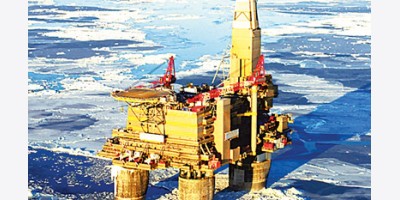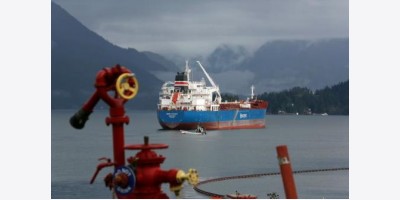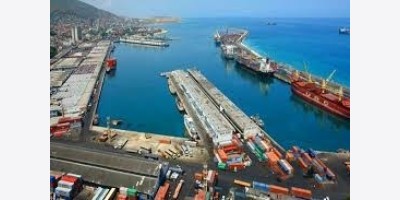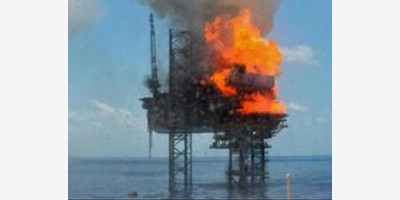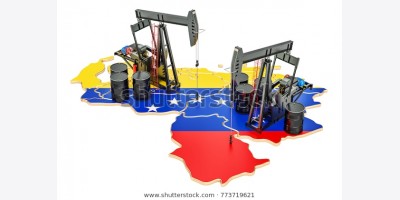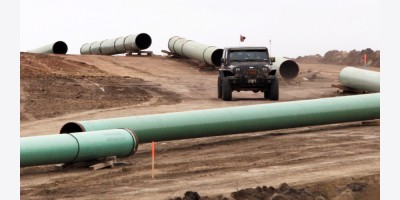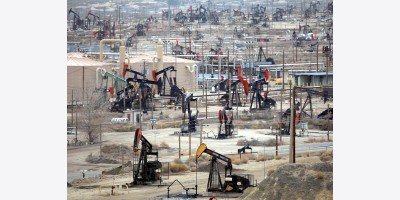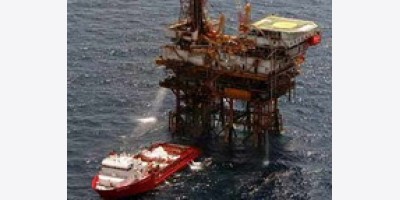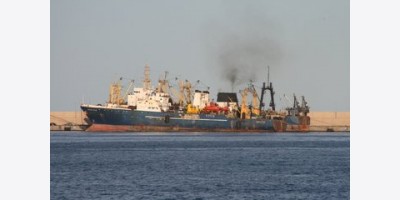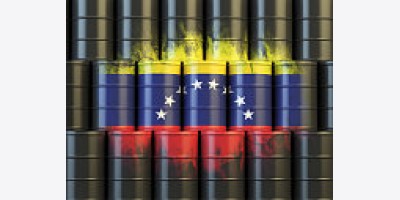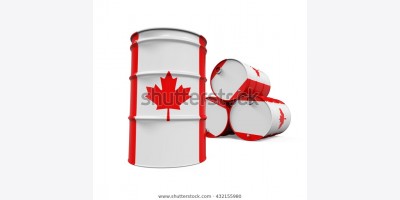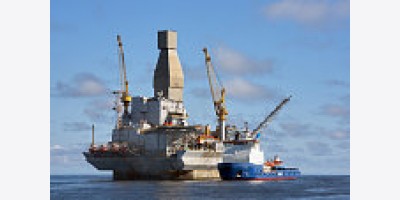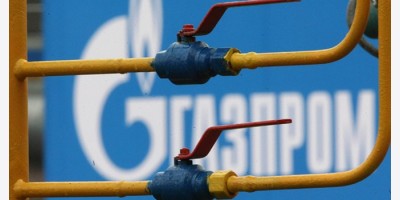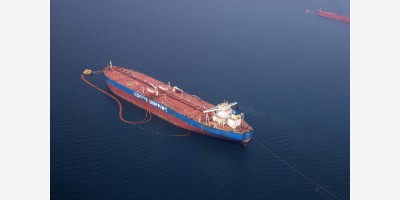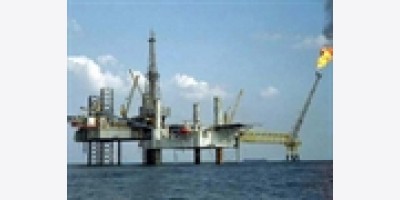Saudi Arabia will need to keep cutting oil output to sustain prices above $100 a barrel, even after the kingdom’s largest reduction in two years, according to BNP Paribas SA and Societe Generale SA.
The world’s biggest crude exporter told OPEC last week it pumped 408,000 barrels a day less last month, about as much as Australia produces. Output rose in Iran, Iraq and Nigeria, adding to supply that drove benchmark Brent crude futures below $100 this month for the first time since June 2013. Saudi Arabia probably will have to cut a similar amount again to stabilize prices, the banks said.
Global oil demand growth this year will be the weakest since 2011, just as the U.S. shale boom means oil production from countries outside OPEC rises by the most since the 1980s, according to the International Energy Agency. The glut is prompting most of OPEC’s Middle Eastern members, including Saudi Arabia, to cut prices to customers.
“We are swimming in crude and they know that better than anyone because they are the biggest exporter,” Mike Wittner, the head of oil market research at Societe Generale in New York, said by phone Sept. 9. “History shows that the Saudis will just do what’s necessary.”
Industrial Output
Brent crude traded at about $99 a barrel yesterday, compared with a range of $95 to $110 described as “fair” by Saudi Oil Minister Ali Al-Naimi at a meeting of the Organization of Petroleum Exporting Countries in June.
Futures fell to $96.21 on Sept. 15, the lowest in two years, as China’s industrial output expanded at the weakest pace since the global financial crisis in 2008. China will account for about 11 percent of global oil demand this year, compared with 21 percent for the U.S., according to the IEA.
Saudi Arabia made the biggest contribution to OPEC’s production cuts in 2008 and 2009 as demand contracted amid the financial crisis. The group took almost 5 million barrels of daily output off the market, reviving prices from about $30 at the end of 2008 to almost $80 a year later.
The kingdom “will act to stabilize and then shore up the oil price, not only because it is in its interest, but in the interest of fellow OPEC members in the Middle East,” Harry Tchilinguirian, BNP’s head of commodities markets strategy in London, wrote in an e-mail Sept. 11.
A Saudi Oil Ministry media official declined to comment on the nation’s policies when contacted by phone yesterday, declining to be identified citing government policy.
Government Budget
Brent will average $107 in the fourth quarter and $105 in 2015, according to the median of as many as 31 analyst estimates compiled by Bloomberg. Brent may average $90 in the fourth quarter if Saudi chooses not to keep cutting output, according to Societe Generale’s Wittner.
Petroleum exports account for about 90 percent of Saudi Arabia’s state budget. King Abdullah announced $130 billion of investment in 2011 to create jobs and a $500 billion plan to build cities in the desert started last year.
Saudi Arabia may also want to boost oil prices to aid Iraq, the second-largest OPEC producer, as it battles the spread of Islamic State in the north, according to Tchilinguirian.
Saudi Arabia will probably reduce production by a further 500,000 barrels a day in the fourth quarter as the summer peak in domestic demand for power generation passes, according to Julian Lee, a strategist at Bloomberg News in London. The kingdom burned 827,000 barrels a day to generate power in June, the most in four years, according to the Riyadh-based Joint Data Initiative.
Oil Prices
OPEC officials, including Saudi Arabia’s Naimi, have said they see no urgent need to respond to the drop in oil prices, which are still more than twice their level a decade ago.
Prices “always fluctuate and this is normal,” Naimi told reporters in Kuwait on Sept. 11. The decline is a seasonal fluctuation and prices will recover by the end of the year, Secretary-General Abdalla El-Badri said in Vienna yesterday. The group’s output may fall to 29.5 million barrels a day from about 30 million currently, El-Badri said.
There may be incentives for Saudi Arabia to let oil continue its decline, according to Bank of America Corp. and DNB ASA, Norway’s biggest bank.
Allowing Brent to fall below $85 could slow the U.S. shale boom because some producers would lose money pumping at that price, Francisco Blanch, head of commodities research at Bank of America, said in a report Sept. 9.
U.S. crude output will climb by 1 million barrels a day to 9.53 million next year, the most since 1970, Adam Sieminski, the administrator of the U.S. Energy Information Administration, said in a statement Sept. 9.
Fiscal Firepower
Curtailing the shale boom would ensure continued U.S. reliance on Middle Eastern energy, Bank of America’s Blanch said. Saudi Arabia’s crude exports to the world’s biggest oil user fell to 1 million barrels a day in June, compared with an average of 1.4 million in the first five months, according to the IEA, a Paris-based adviser to 29 industrial nations.
“For Saudi Arabia, I can’t see why they’d come in and manage prices unless it falls below $90,” Torbjoern Kjus, an analyst at DNB in Oslo, said by phone Sept. 10. “It benefits the Saudis to test where the limit is for U.S. shale.”
OPEC’s de facto leader has the “fiscal firepower” to tolerate prices as low as $70 for two years without experiencing economic difficulties, according to Energy Aspects Ltd., a consultant in London. The kingdom held reserve assets valued at $741.6 billion in July, almost double the level five years earlier, according to the Saudi Arabia Monetary Agency.
Discount Reversed
Saudi Arabia shouldn’t focus on price levels alone, according to Seth Kleinman, the head of European energy research at Citigroup Inc. in London.
Production cuts are necessary to reverse the discount on immediate versus later deliveries of crude, a market structure known as contango which encourages traders to stockpile crude, he said. That stored oil can return to the market outside of the kingdom’s control, potentially thwarting efforts to stabilize prices, he said.
“This market’s clearly significantly oversupplied,” Kleinman said by phone. “It’s not just the $100 mark, which everyone’s looking at, it’s the fact you’ve got this steep contango.”
The cease-fire in Ukraine showed more signs of strain as rebels questioned further peace talks with the government, even after lawmakers in Kiev approved special status for the country’s two easternmost regions.
Some separatist groups called for a renewed offensive and a rebel leader accused the government of violating the terms of a truce accord signed Sept. 5. Clashes continued yesterday near Donetsk, the largest city in the conflict zone, where the airport has been the site of some of the heaviest fighting.
The uncertainty about the peace process overshadowed the ratification of Ukraine’s association agreement with the European Union on the same day that lawmakers approved a law expanding the powers of the Donetsk and Luhansk regions. The bill falls short of Russia’s demands, according to Otilia Dhand, an analyst at Teneo Intelligence in London.
“The key point, the right of regions to influence foreign policy decisions, is not included,” she said in an e-mailed note. An “intensification of clashes will likely continue.”
Russian President Vladimir Putin wants to turn Luhansk and Donetsk into quasi-statelets with the right to veto major national initiatives, such as Ukraine joining NATO, according to five current and former Russian officials and advisers.
Ukraine’s government bonds due 2017 fell, pushing the yield up to 13.9 percent, the highest level since May 12, data compiled by Bloomberg show. The ruble tumbled to a record for a fourth day in Moscow.
‘No Sense’
There’s “no sense” in continuing peace talks because the government is failing to meet the terms of a prisoner-swap agreement that was part of the truce accord signed Sept. 5, Alexander Zakharchenko, the premier of the self-proclaimed Donetsk People’s Republic, said in a website statement yesterday. The sides had planned to meet this week in Minsk, Belarus, though no date had been set.
Pro-Russian rebels earlier suggested combining the forces in Luhansk and Donetsk and switching to “offensive tactics,” according to an address to separatist leaders posted on the Donetsk insurgents’ website. The conflict has claimed more than 3,000 lives, according to the United Nations, and clashes have occurred daily since the truce took effect.
Government troops were holding their positions and observed the truce, Andriy Lysenko, a spokesman for the Ukrainian military, told reporters in Kiev. They continued to come under fire, he said.
The situation in Donetsk remains “tense” after one civilian was killed yesterday and the city council reported intensive military operations in two of its districts. It was quiet as of 6 p.m. local time, the council said on its website.
‘Effective Steps’
Under the measures approved by Ukrainian lawmakers yesterday, certain areas controlled by pro-Russian separatists will hold early local elections on Dec. 7, enjoy a special economic and investment regime and have the right to use Russian as a second official language.
The new laws may be a step toward peace if the rebels take “effective steps as well,” Ukrainian President Petro Poroshenko said in a statement on his website.
The U.S. urged “Russia and the separatists it backs to reciprocate” and begin full implementation of the cease-fire agreement, State Department spokeswoman Marie Harf said in an e-mailed statement. The government in Moscow denies involvement in the conflict.
The U.S. and other NATO allies began military exercises this week in Ukraine, which says Russia has about 25,000 troops along the border and more than 3,000 soldiers in the country.
‘Very Fragile’
The drills have “the potential to lead to a destabilization of the situation,” Dmitry Peskov, a spokesman for Putin, said in a phone interview yesterday before Zakharchenko’s comment. “The truce is very fragile. It is just the start of the settlement. Russia consistently continues to do all it can to help promote the resolution of Ukraine’s internal crisis.”
Peskov declined to comment on Ukraine’s status law or future of the peace talks.
Ukraine’s EU association accord takes effect on Nov. 1, and should deepen ties between the conflict-torn country and the 28-member bloc. Poroshenko said his nation has “paid the highest price for its EU choice.” The measure was also ratified by the European Parliament in Strasbourg, France.
Implementation of the free-trade agreement was delayed until Dec. 2015, with Poroshenko saying it gives the country extra time to boost its competitiveness.
OPEC may cut production by 500,000 barrels a day next year, according to El-Badri.
OPEC, the group supplying about 40 percent of the world’s oil, may cut production next year, its Secretary-General Abdalla El-Badri said.
The Organization of Petroleum Exporting Countries’ daily output target could fall by 500,000 barrels to 29.5 million barrels in 2015, El-Badri said at OPEC’s secretariat in Vienna after talks with Russian Energy Minister Alexander Novak today. The group’s monthly report on Sept. 10 showed demand for its oil will drop to 29.2 million barrels a day in 2015 from 29.5 million this year.
Saudi Arabia cut its crude supply by 408,000 barrels a day in August, the biggest reduction since the end of 2012, a submission made by the country to OPEC shows. Brent crude is trading below $99 a barrel and is close to the lowest in more than two years. U.S. crude supplies are surging while those from Libya are rebounding and a conflict in Iraq has mostly spared the nation’s exports.
“Our production will be maybe 29.5 million barrels per day in 2015, not 30 million barrels,” El-Badri said. “This is an outlook, not a decision.”
Brent crude futures advanced after El-Badri’s remarks, climbing as much as $1.17, or 1.2 percent, to $99.05 a barrel on the ICE Futures Europe exchange. Prices have lost about 14 percent since mid-June, when Islamic State fighters gained territory in Iraq. The grade was at $98.83 at 4:10 p.m. London time.
Price Rebound
“I am not really concerned about the prices declining at this short term,” El-Badri said. “This is a fluctuation of seasonal behavior. When we’re coming to the fall, things will look better. I think the price will rebound by the end of the year.”
OPEC officials, including Saudi Arabian Oil Minister Ali Al-Naimi, have said they see no urgent need to respond to oil’s drop. Prices “always fluctuate and this is normal,” Naimi told reporters in Kuwait on Sept. 11. Oil will recover as demand for winter fuels climbs, Kuwaiti Oil Minister Ali Al-Omair said the same day. The group is next due to meet on Nov. 27.
Russian and OPEC analysts will meet in spring, Russian Energy Ministry spokeswoman Olga Golant said by text message. “High-level” talks are scheduled for the second half of 2015, according to a joint statement from OPEC and Russia today.
Workers at Nigerian National Petroleum Corp., the country’s state-owned oil company, yesterday began an indefinite strike over pension terms that may disrupt crude output from Africa’s top producer and affect its domestic gasoline supplies, a labor union official said.
“We have total shutdown at NNPC offices and all their subsidiaries, and that may affect the exports,” Babatunde Oke, a Lagos-based spokesman for both a managers’ union and a blue-collar workers’ union, said by phone. “The refinery workers are also not working.”
Staff operating flow stations that pump crude to export terminals are joining the action, meaning a protracted strike could disrupt cargoes, Oke said. Domestic gasoline supplies may also fall short as the workers protest pension terms at NNPC, he said.
Nigeria is the continent’s largest oil producer and relies on the commodity for over 70 percent of government revenue and 95 percent of foreign-exchange income. The West African nation pumped 2.3 million barrels a day of oil in August, the most since 2006, according to data compiled by Bloomberg.
The NNPC runs joint ventures with Royal Dutch Shell Plc (RDSA), Chevron Corp. (CVX), Exxon Mobil Corp. (XOM), Total SA (FP) and Eni SpA (ENI) that pump about 80 percent of Nigeria’s crude.
“Based on precedent there are a few days’ cushion, from storage capacity,” before exports are curtailed,’’ Philippe de Pontet, a director at New York-based corporate advisory company Eurasia Group, said in an e-mailed note to clients. President Goodluck Jonathan and the ruling party “have an overriding political interest in ending the strike as soon as possible to keep oil revenues flowing; it has the will and the means to do so.”
Union leaders should “exercise restraint,” the state-owned company said in a statement. Measures have been taken to reduce the pensions’ deficit to 85 billion naira ($520 million) currently from 298 billion naira in 2010, it said.
Oke is a spokesman for both the Petroleum and Natural Gas Senior Staff Association of Nigeria, a managers’ union, and the National Union of Petroleum and Natural Gas Workers.
Argentina’s oil-producing provinces and the federal government agreed to revise a 1967 energy bill to include shale, two provincial officials said.
Governors of 10 oil provinces and federal authorities will present the final draft to President Cristina Fernandez de Kirchner later today and the bill will be sent to Congress this week for approval, they said. Both people asked not to be named because negotiations are private.
Provincial governors and federal authorities have been negotiating for four months to replace the 1967 hydrocarbons law, including how to distribute revenue from the world’s fourth-biggest shale oil reserves and second-largest shale gas reserves in southwestern Argentina’s Vaca Muerta formation. The draft includes benefits for oil producers investing in shale and offshore projects.
The new legislation will ease political tensions stemming from unclear rules governing the country’s nascent shale boom and is expected to attract investors to areas such as Vaca Muerta, a Belgium-sized shale formation where companies such as Chevron Corp. (CVX), Royal DutchShell Plc (RDSA), Exxon Mobil Corp. (XOM) are drilling wells. State-run producer YPF SA (YPF) would probably benefit most from the changes, the people said.
Horacio Mizrahi, a spokesman for federal Planning Minister Julio De Vido, didn’t respond to a phone call and an e-mail seeking comment. Chubut Governor Martin Buzzi, who heads the committee of the 10 provinces, and Neuquen Governor Jorge Sapag weren’t available to comment, as they were participating in a meeting on the energy bill, their assistants said.
Export Revenue
The new bill will allow energy companies that invest $250 million over a five-year period to sell 20 percent of production in international markets without paying export taxes and to keep some export revenue outside the country for shale and conventional projects. This benefit would apply to 60 percent of output from offshore projects, the people said. A few governors sought to reduce the period to three years, they said.
The bill will split activities between conventional, shale, and offshore to include the latter two areas, which weren’t part of the 1967 bill. Shale and offshore fields will have concessions granted for as many as 35 years. Royalties will be capped at the same level nationwide and provinces will agree to a unified federal auction system that will replace the current one that varies from province to province.
American depositary receipts for YPF SA, Argentina’s largest oil company that Fernandez expropriated from Repsol SA in 2012, gained 5.2 percent to $37.55 at the close in New York. The ADRs, which each represent one ordinary share, rose to the highest since July 30, when Argentina was declared in technical default.
PARIS, Sept. 16 (UPI) -- On the heels of reports predicting low oil demand, a director at the OECD said from France the global economy was expanding at only a moderate pace.
Rintaro Tamaki, acting chief economist at the Organization for Economic Cooperation and Development, said during the presentation of an interim economic assessment in Paris the global economy was experiencing lopsided growth.
"The global economy is expanding unevenly, and at only a moderate rate," he said during Monday's presentation. "The continued failure to generate strong, balanced and inclusive growth underlines the urgency of undertaking ambitious reforms."
The International Energy Agency published its monthly market report for September last week, trimming oil demand growth for 2014 to 900,000 barrels of oil per day and 2015 to 1.2 million bpd. The agency, which has headquarters in Paris, said the assessment was made because of a "pronounced slowdown" and weaker outlook for Europe and China.
OECD expects the U.S. economy to grow by 3.1 percent in 2015, up from the 2.1 percent forecast for 2014. For Europe, growth is slow, rising from 0.8 percent in 2014 to 1.1 percent next year. The Chinese economy, meanwhile, is slowing. OECD expects Chinese growth of 7.3 percent, down from 7.4 percent in 2014 and 7.7 percent the previous year.
ERBIL, Iraq, Sept. 16 (UPI) -- Settling claims over which entity has the authority to sell Iraqi crude oil is a matter for the Iraqi courts, the Kurdistan Regional Government said.
The semiautonomous KRG filed suit in a U.S. court challenging a filing from Baghdad requesting the seizure of oil loaded on the United Kalavrvta tanker parked off the coast of Galveston, Texas.
Lawyers for the government in charge of roughly the northeastern third of Iraq argued the U.S. court system is no place for the legal battle.
"This is a dispute firmly rooted in Iraq, and it will not and cannot be resolved by application of maritime law," the Monday filing said.
Baghdad, in a separate filing in a Greek court last week, accused Marine Management Services of turning off transponders on the United Kalavrvta to avoid detection and conducting ship-to-ship oil transfers at sea.
U.S. courts have said the dispute stems from where the oil was extracted. Both Iraqi governments have made competing claims over who has the right to export oil. Washington sided with Baghdad, but said the issue was a commercial matter.
Previous seizure requests were denied because the vessel in question was outside U.S. territorial waters.
NEW ORLEANS, Sept. 15 (UPI) -- A natural gas pipeline off the coast of Louisiana was closed Monday in response to a deadly accident, Chevron Pipe Line Co. said.
Chevron was mum on the details surrounding the accident, but revealed a contract worker died and two others were injured while performing routine maintenance on a pipeline at a site six miles off the coast of Louisiana.
The company said in a statement it "regrets" the accident and announced the pipeline was shut down Monday so a site investigation can proceed.
Chevron's pipeline provides fuel to the Henry Hub storage facility in Louisiana, considered the benchmark site for U.S. gas pricing. Chevron Pipeline Co. said it was rerouting most of the gas to through a different pipeline.
Louisiana officials said the line experienced a valve failure Saturday. There were no reports of sheen at the site.
PARIS, Sept. 16 (UPI) -- French engineering company Technip said Tuesday it won a refinery contract in Bahrain that could increase output by 34 percent.
The Bahrain Petroleum Co. awarded Technip with an engineering contract to build new refinery units in the Persian Gulf kingdom. The company said work to increase refinery output from 267,000 to 360,000 barrels per day will be completed by the end of next year.
No value of the contract was given and there was no corresponding statement from the Bahrain company. Technip, however, characterized the contract as "significant," saying it was valued at between $65 million and $130 million.
Bahrain refinery capacity exceeds domestic oil production of around 48,000 bpd. Though it's not a member of the Organization of Petroleum Exporting Countries, it shares with OPEC member Saudi Arabia production from the Abu Safah offshore field.
STAVANGER, Norway, Sept. 16 (UPI) -- Oil production from Norwegian territory in August was 10 percent higher than what was predicted, the Norwegian Petroleum Directorate said Tuesday.
NPD said average daily oil production of 1.48 million barrels per day in August was 10 percent above what was expected and 1 percent about what was produced during the same month in 2013.
"So far this year the oil production is about 2 percent above the NPD's prognosis," the agency said in its monthly report.
Total gas sales from Norwegian operations were around 257 billion cubic feet in August, about 9 percent less than the previous month.
NPD attributed some of the variations to fields closed in August due to regular maintenance and technical problems.
Norway has more oil reserves than any other European country. Last year, it exported 1.19 million bpd worth of oil, with most of that headed to the British and Dutch economies.
In terms of gas, it's the third largest exporter in the world behind Russia and Qatar.
KIEV, Ukraine, Sept. 16 (UPI) -- Reliable natural gas deliveries to Europe depend largely on contractual issues in Ukraine, Russian energy company Gazprom said Tuesday.
Gazprom in June cut gas supplies to Ukraine because of ongoing disputes over pricing and debt. Ukraine pays some of the highest prices for natural gas in the region. Russia had offered a discounted price, though the Ukrainian government said it suspected the offer was politically motivated.
Russia meets about a quarter of Europe's gas needs, though most of that gas runs through the Soviet-era transit network in Ukraine. Similar rows in 2006 and 2009 left European consumers in the cold and Gazprom says the onus is now on Ukraine.
"The reliability of these supplies [to Europe this winter] can be ensured only on the condition that Naftogaz of Ukraine strictly observes its transit contract," Gazprom said in a statement.
The announcement comes as the Ukrainian government ratified an association deal with the European Union. A tilt toward the EU in November led to political upheaval in Kiev and the annexation by Russia of the Crimean Peninsula of Ukraine.
The EU and its Western allies have issued sanctions on the Russian energy sector in response to the conflict. Russian Deputy Foreign Minister Sergei Ryabkov told state news agency RIA Novosti sanctions were a violation of international law.
RIO DE JANEIRO, Sept 16 (Reuters) - Brazil's biggest oil field Libra, located off the coast of Rio de Janeiro, will cost $80 billion to develop, an executive at consortium member Total said on Tuesday.
Libra, in the Santos Basin, contains an estimated 8 billion to 12 billion barrels of oil.
"(Libra) will give us a return on our investment for many decades," Ladislas Paszkiewicz, Total's vice president for exploration and production in the Americas, said at a conference in Rio de Janeiro.
Paszkiewicz did not offer any further details on the financial plans for the project.
The Libra consortium is led by state-run oil firm Petroleo Brasileiro SA, or Petrobras, with a 40 percent stake. Total and Royal Dutch Shell Plc both have 20 percent while China's National Petroleum Corp and CNOOC have 10 percent each.
Rigzone Staff
http://images.rigzone.com/images/home/article/hf_135036_article.jpg
Domestic unconventional oil and gas production will help raise US energy exports by about 5% per year through 2030, according to HSBC's Global Connections Trade Forecast.
The rapid rise in U.S. unconventional oil and natural gas production will help boost U.S. energy exports by around 5 percent per year through 2030, according to the September 2014 U.S. HSBC Global Connections Trade Forecast.
Imports of petroleum are expected to decline from 12 percent in the near-term to 7 percent in the long-term, according to HSBC report, which highlights the global trade outlook for the United States by sectors such as energy and healthcare.
Emerging markets that don’t have refining capabilities or don’t dispose of energy reserves could represent a major opportunity for U.S. energy exporters, said Derrick Ragland, executive vice president and head of U.S. Middle Market Corporate Banking, HSBC Bank USA N.A., in a Sept. 16 press release.
Chemical plant expansions and liquefied natural gas (LNG) terminal upgrades, coupled with the opening of Mexico’s energy industry to foreign investment, are expected to result in a new export boom for Houston and to create over 55,000 new jobs, according to a May 2014 report by HSBC. The massive investment in chemical plants and LNG export terminals has fed a second boom as Houston’s engineering, construction and fabrication firms design and construct these plants.
Innovations in hydraulic fracturing and directional drilling, which have unlocked the United States’ shale resources, is behind this boom, HSBC said in the May 2014 report. Local firms that supply the chemical and energy industries also will see their business grow as clients demand more of everything they need to expand overseas operations.
The United States’ rise as a major player in global energy markets is of particular importance for U.S. trade, as the rapid rise of U.S. unconventional oil and gas production cut the U.S. petroleum balance by nearly 50 percent since year-end 2008.
“While the ban on crude oil exports is unlikely to be lifted soon, exports of refined products will contribute to export growth in the years to come,” according to HSBC.
U.S. businesses are increasingly looking to emerging markets for export growth in the short and long-term. U.S. businesses are well-positioned to take advantage of a stronger world economy, and an increasing focus on fast-growing emerging markets will prove essential, according to HSBC.
“While advanced economies – primarily in Europe – will continue to dominate the U.S. trade sector, Asia and Latin America will become more important export destinations for U.S. exporters,” said HSBC on the longer-term trade outlook.
U.S. exports are expected to grow by approximately 6 percent each year through 2030. China and India are predicted to be the best trade prospects for the United States, with U.S. export growth estimated to average 9 percent per year to each country through 2030, HSBC said.
On a global basis, trade is expected to rise by 8 percent per year starting in 2016 from 2.5 percent in 2013. Longer term forecasts indicate global merchandise trade will more than triple by 2030 from 2013 levels as businesses capitalize on the rise of the emerging market consumer and developing markets stabilize their productivity levels for the future, according to HSBC.
“A highly educated workforce, well-developed production processes and innovative technology will help U.S. businesses plug into increased trade flows, while the rise of the emerging market consumer is helping to lift demand,” said Steve Bottomley, HSBC group general manager, senior executive vice president and head of commercial banking for HSBC in North America.
NEW YORK, Sept 16 (Reuters) - U.S. crude futures rose by almost $2 and Brent by more than $1 on Tuesday on the prospect of a production cut by OPEC as well as on a weakening dollar and news that Libya had curbed output after rockets hit an area near a refinery.
The dollar began selling off just ahead of a meeting of the U.S. Federal Reserve, sending the euro to a near two-week high against the U.S. currency, and boosting both Brent and U.S. crude, brokers said.
A weakening dollar makes it cheaper for holders of other currencies to purchase crude oil contracts priced in dollars.
"The weakening dollar is supporting both benchmarks," said John Kilduff, a partner at Again Capital LLC.
November Brent rose $1.17 to settle at $99.05 a barrel. The October contract expired and went off the board on Monday at $96.21.
Brent is down 11 percent in the third quarter, its biggest quarterly drop since the second quarter of 2012. It fell to a 26-month low on Monday, tumbling from above $115 in June because of supply increases and sluggish growth in demand.
The front-month U.S. October crude settled $1.96 higher at $94.88 a barrel, after earlier touching a high of $95.15. The October contract expires on Sept. 22.
Oil prices rose earlier in the day after Russia said that deploying troops in Crimea, which Russia annexed from Ukraine in March, was a top priority with NATO holding military exercises in Ukraine near its border with Poland.
Oil prices also received an early boost after OPEC Secretary General Abdallah El-Badri told reporters he expected the group to lower its oil output target to 29.5 million barrels per day (bpd) from 30 million bpd when it next meets in late November.
On Tuesday Libya's state-run National Oil Corp said the El Sharara 340,000-bpd oil field slightly reduced production after rockets hit an area near the Zawiya refinery.
Fighting between rival armed groups resulted in rockets landing close to the refinery connected to the field.
"The talk of OPEC reducing production has given us a boost and the Libya news is important because the market was expecting the recovery of that country's exports to continue," said Phil Flynn, analyst at Price Futures Group in Chicago.
The recent steep drop in oil prices had prompted speculation that OPEC would reduce output to support prices, and Badri's comments marked the first official confirmation that such a move might occur. It would be the first cut by the cartel since 2008.
US Inventories
U.S. crude and distillate inventories rose by 3.3 million barrels last week, compared with the 1.6 million decrease expected, while gasoline stockpiles decreased by 1.2 million barrels, data from industry group the American Petroleum Institute showed on Tuesday.
The more closely watched inventories report from the U.S. government's Energy Information Administration is to be released at 10:30 a.m. EDT (1430 GMT) on Wednesday.
Crude stocks are expected to have fallen by 1.6 million barrels, according to Monday's Reuters survey of analysts.
Copyright 2014 Thomson Reuters.
New York (Platts)--16Sep2014/340 pm EDT/1940 GMT
CCI Corpus Christi's condensate export splitter project, geared towards finding a home outside of the US for rapidly growing North American production of ultra-light, sweet liquids, moved forward Monday after receiving federal environmental regulatory approval.
With domestic refineries reaching their saturation point when it comes to the processing of light, sweet crude, US producers are looking for export outlets in order to keep prices high enough to fund exploration and production in unconventional plays such as Texas' Eagle Ford Shale.
CCI Corpus Christi, owned by merchant commodities firm Castleton Commodities International, still needs two further state environmental permits before construction can begin on Phase I of its planned 100,000 b/d facility, a spokeswoman for the Texas Commission on Environmental Quality said Tuesday.
"There are two air permits under technical review," said TCEQ spokeswoman Andrea Morrow, adding that the project needs approval of its New Source Review (NSR) and Prevention of Significant Deterioration (PSD) permit applications.
Both relate to air quality and permitted levels of emissions, she said, adding that there is no timeframe for when the approvals for the two outstanding permits will be given.
"A technical review varies tremendously based on the scope of the project," Morrow said, adding that the review is considered complete when the engineers are satisfied and sign off on it.
However, a 40-year ban on crude oil exports to most countries means potential exporters like CCI Corpus Christi need explicit export permission from the US Department of Commerce before they can ship out any liquids.
Two companies, oil and natural gas producer Pioneer Natural Resources and midstream giant Enterprise Products Partners, received approval during the summer to export a cargo each of processed condensate to Asia.
The port of Corpus Christi is located near the Eagle Ford Shale play, where production was up to 1.5 million b/d in July from 411,000 b/d in July 2013, according to data from Bentek Energy. Bentek Energy is a unit of Platts.
During Phase 1 of the project, CCI plans to build a condensate splitter with two 50,000 b/d splitter trains, as well as associated equipment. The second phase of the project will include construction of a bulk terminal capable of exporting 500,000 b/d of not only condensate but diesel, jet fuel, naphtha, gasoil, and Y-grade liquids, according to the PSD permit application made with the TCEQ.
A Castleton spokeswoman was not available for comment Tuesday. Prior to January 2013, Castleton Commodities International LLC was known as Louis-Dreyfus Highbridge Energy.
London (Platts)--16Sep2014/959 am EDT/1359 GMT
The average German gas import price in July was down 8.4% from June at Eur20.60/MWh, and down 25.0% from the price in July 2013, according to data from German customs agency BAFA released Tuesday.
The price reflects gas at Germany's borders, whether based on spot market prices or long-term contracts indexed to the spot market or to the oil market.
The average day-ahead German gas price in the spot market in July was lower, at Eur16.48/MWh for GASPOOL and Eur16.67/MWh for NetConnect Germany, according to Platts assessments.
Long-term contracts indexed to oil may be priced above the spot market, pulling up the average import price.
The volume of gas imported into Germany in July was 246,956 terajoules (6.5 billion cubic meters), down 18.8% from the same month of 2013.
In 2013 Germany needed to import large volumes of gas to refill its storage facilities after a cold winter. But winter was fairly mild this year, meaning less gas has been needed for storage injections.
From January to July 2014 German gas import volumes at a total 1,968,474 terajoules fell 8.7% below the same months of 2013.
The three most important suppliers in the January-July period were Russia at 757,112 TJ, Norway at 649,403 TJ and the Netherlands at 464,892 TJ.
The value of gas imports from Russian, Dutch, Norwegian, Danish and British sources in the January-July period was Eur13.3 billion ($17.2 billion), compared with Eur16.8 billion in the same period the year before.
Singapore (Platts)--16Sep2014/430 am EDT/830 GMT
South Korean LNG imports in August were 22% lower year on year for the sixth straight month, at 2.54 million mt, customs data released Monday, September 15, by the Customs Service showed.
August imports increased 17% from June, which were the lowest imports since August 2011, Platts data showed.
South Korea has had lower domestic demand for LNG, following a warm winter and cool summer, which has resulted in a high inventory build.
As Kogas was still scheduled to receive more LNG from term contracts with its long-term suppliers, the monopoly LNG buyer has had to find ways to manage its terminal operations, while balancing the need to keep its relationships with key producers intact.
This year, Kogas was heard to be using a combination of downward tolerance clauses and deferral of volumes in long-term contracts, as well as utilizing time swaps with other North Asian buyers, to help them deal with their high inventories.
"I'm not too sure [how they have managed to deal with their situation], but I think they are managing it pretty well," a Singapore-based trader said.
Sources have recently said that Kogas was able to fix its delivery schedule for September and October, though it was unclear whether it would need to reschedule some of its shipments in November and December.
Kogas' imports from Indonesia, Malaysia, Oman, and Yemen were down 22%, 64%, 14%, and 36%, indicating that it was successful in deferring some cargoes from its long-term suppliers.
After four months of declining year-on-year volumes, imports from Kogas' largest long-term producer, Qatar, finally showed signs of recovery, with imports rising 17% on the year, and 23% from the previous month to 950,093 mt.
Qatar has previously borne the brunt of declining demand from Kogas, with exports from the Middle Eastern country so far this year down around 1.8 million mt, Platts data showed.
South Korea's LNG import prices averaged $842.25/mt ($16.20/MMBtu) in August, down 0.8% from July, but 10% higher year on year.
Moscow (Platts)--16Sep2014/1000 am EDT/1400 GMT
OPEC secretary general Abdalla el-Badri said Tuesday he expected world oil prices to stage a recovery from two-year lows by the end of this year.
The oil producer group's crude basket, which dipped below the $100/barrel level in mid-August and has been falling since, stood at $94.68/b on Monday.
"The oil price has been falling over the past two months but we believe that the price will grow again by the end of the year," Russian news agency Prime quoted Badri as saying after talks with Russian energy minister Alexander Novak in Vienna.
A joint statement said the talks had reached "a general consensus that the market is well-supplied with healthy stock levels and adequate spare capacity."
Platts Middle East Crude Oil Summit Join 150+ influential upstream leaders and experts from the international oil community as they evaluate and debate the new regional oil landscape. Explore the race for internal and external Asia market share, Iraq and its unstable crude production, Iran and the possible removal of sanctions, and the Middle East's increasing role as a global oil trading hub and what it means for crude flows, pricing and benchmarks moving forward.
Both delegations, the statement said, "also underscored the importance of stable and predictable markets for the health of the industry and investments and the well-being of the global economy."
Russia's budget envisages crude prices for Urals, the country's key export blend, at $96/barrel, and the current decline in oil prices puts pressure on a country already hit by western sanctions over Moscow's role in the Ukrainian conflict.
The sanctions limit access to capital markets for a number of Russian key oil producers and also ban exports of equipment and technology for oil drilling in the Arctic and deepsea as well as for shale.
London (Platts)--16Sep2014/952 am EDT/1352 GMT
The backwardation between Northwest European physical high sulfur fuel oil barges and the front-month swap slumped to $1.75/mt Monday from $2.25/mt Friday due to weak regional demand for barges and amid persistent outflows of material for Asia.
Traders said regional demand for barges remained weak on low bunker interest while selling has picked up for cargoes.
"There is not much pool from regional barges, and no buying interest from the Mediterranean," the source said. On the other hand, there are a lot of cargoes on offer, a trader said.
Traders said large volumes continued to leave the ARA region for Asia amid an open arbitrage.
A new VLCC fixture was made by BP for 270 mt for Singapore delivery for October 10 loading, at a lump sum of $4.65 million, traders said.
Meanwhile, HSFO supply remained balanced due to a steady flow of Russian fuel oil despite the ongoing refinery maintenance season in Russia.
"In the Black Sea exports are unfortunately higher at this moment," one trader said.
While bunker fuel suppliers experienced prompt tightness on HSFO due to logistical issues, the market saw sufficient HSFO supply for forward dates, sources said.
The HSFO derivatives complex followed Monday's softer physical outlook, with the balance month/October 3.5% FOB Rotterdam barge swap structure declining 50 cents/mt to a $2.50/mt backwardation.
The move saw the structure shallow to the slimmest backwardation seen in September, last lower on August 15, when it reached minus $1.50/mt, Platts data shows.
"The market is a bit weaker. Singapore is weaker as they're scared of the volumes that are going to land in October... in Europe the market is back to normal -- it could go lower if no more VLCC are moving East," a trader said.
More than 80 megaprojects, each worth at least $1 billion, are under way or planned for completion by 2030 in Saudi Arabia, according to a new report.
This makes the kingdom the Middle East’s largest megaproject market by a wide margin, said the Meed report released during the third annual Meed Saudi Mega Transport & Infrastructure Projects conference.
The 2014 event opened at the Al Faisaliah Hotel in Riyadh today with a keynote address delivered by Saudi Arabia’s Minister of Economy and Planning Dr Muhammad Al Jasser.
Leading project management firms are focusing growing attention on the opportunities emerging in the megaprojects market of Saudi Arabia.
Speakers at the event are expected to highlight the opportunities emerging in the kingdom’s large-scale projects market. They include Saudi Aramco’s plan to invest $40 billion a year over the next decade to keep oil production capacity steady and double gas production. The $20-billion Riyadh Metro is another major project under implementation. Further major metro projects are planned for Makkah and Jeddah.
“The conference will concentrate on finding solutions to the megaproject challenge the kingdom faces,” said Meed Event’s chairman Edmund O’Sullivan, who is moderating the event.
“The resurgence of large scale and complex projects and programmes being developed in the GCC region continues to present delivery challenges to the megaproject industry,” said CH2M Hill Saudi Arabia country manager Amer Khan.
“Part of the overall holistic solution is to implement tailored programme management methodologies for mega project delivery with strategic level integrated teams comprising project owners, sponsors and world class delivery professionals.”
“The Saudi Arabian megaproject market is an exciting, challenging and rapidly growing entity,” said Faithful & Gould regional development director David Clifton. “To ensure successful delivery, we need to ensure global best practice, procedures and systems are both brought and then tailored to the market and implanted. Further, with the rapid rise of major programmes, we need to develop intelligent procurement as the supply stretches and capacity is taken up by multiple mega programs running concurrently.”
Technology will play a critical role in the implementation of these projects.
“The construction industry which includes design, engineering and construction has been plagued by flat and declining productivity, low growth and constant complaints about margin compression,” said global head of programme management at Arcadis Julio Maggi.
“There has been very little innovation. We really don’t’ design things any better, faster or cheaper than we have done in the past. So we are no delivering value to the client that you see happening in the microchip industry for example.”
“There needs to be more innovation and a wider embrace of the technologies that are emerging including robotics, 3-D printing and driverless vehicles. A wider adoption of BIM would be beneficial, particularly in large infrastructure programmes. Saudi Arabia has a vision for 2025,” Maggi said.
The importance of information management and full lifecycle BIM on megaprojects will the subject of a special breakfast briefing at the conference on September 17, hosted by Bentley Systems. - TradeArabia News Service
A multi-billion-dollar project to raise Bahrain Petroleum Company’s (Bapco) refining capacity by 100,000 barrels per day (bpd) is on track with the signing of the front-end engineering and design (Feed) contract yesterday (September 15).
Project management, engineering and construction firm Technip Italy will carry out the Feed for the Bapco Modernisation Programme (BMP), said a report in the Gulf Daily News (GDN), our sister publication.
The programme is Bapco's most ambitious project to-date and is estimated to cost upwards of $5 billion.
The Feed contract will take 16 months to complete and cost about $55 million, Technip Italy chief executive Marco Villa told the GDN after signing the contract with Bapco chief executive Dr Peter Bartlett at the Bapco Club in Awali.
Villa said Technip, operating from its office in Rome, Italy, is confident of completing the front-end development work on schedule and within cost.
The company will also utilise its offices in Abu Dhabi and its high-value engineering centre in Greece for the project, he added.
Dr Bartlett said the BMP comprises a group of related projects managed in a co-ordinated way to obtain maximum benefits.
“It follows a $1.2 billion Strategic Investment Programme, as a result of which the refinery is now the first in the Middle East with the capability to produce nearly 100,000 bpd of Euro V diesel and Group III lube oil base stock.”
A key aim of the BMP is to improve gross refining margins and cost-efficiencies, he said.
The refinery configuration post-BMP would allow for higher throughput, improved product quality and ensure Bapco's continued competitiveness under a wide range of prices and market scenarios, Dr Bartlett added.
According to him, the BMP would also improve energy efficiency and address all local environmental compliance requirements anticipated in the near future.
Key projects include a crude unit and associated facilities, hydrocracker and associated facilities, residue conversion units and a waste treatment facility.
“The residue conversion unit will open access to cheaper feedstock of heavy crude oil and thus, a larger diversity of sources of supply,” he said.
The hydrocracker and associated facilities will include a new hydrocracking unit with 60,000 bpd capacity, expansion of the mild hydrocracking unit from 54,000 bpd to 70,000 bpd capacity and a new fluid catalytic cracker.
A dehydrosulphurisation unit is also planned to produce diesel according to international standards with sulphur content of less than 10 parts per million.
Dr Bartlett said once the design packages are finalised by early 2016, the engineering, procurement and construction stage would begin with commissioning of the new units expected by 2020.
Bapco's current refining capacity is 265,000 bpd. - TradeArabia News Service
MOSCOW, 13 hours, 48 minutes ago
Russian Energy Minister Alexander Novak will meet the Organization of the Petroleum Exporting Countries (Opec) officials in Vienna, his spokeswoman said, as oil's price fall piled pressure on Moscow's budget.
The annual meeting had been planned long before oil fell below the $100 per barrel level critical for Russia's oil sales which account for 40 per cent of state budget revenues.
Russia suffered from a decline of oil production and prices this year and has cut its outlook for oil output as core Western Siberian fields become more depleted.
The spokeswoman said that Novak and the officials from Opec had not planned to discuss the prices of oil, which hit 26-month low for Brent crude.
However, a government source said that the measures to prop up the prices have long been discussed at the ministry.
"The talk of closer cooperation with Opec on prices have long been there," he said.
So far, Russia, the world's top producer of conventional oil, has ruled out coordinated action with Opec to halt the price decline.
Oil prices have slid due to concern about weakening demand and ample supplies, raising the question of whether Saudi Arabia, holder of the world's largest spare output capacity, will curb output. Brent crude fell below $100 last week for the first time in 14 months.
Opec oil ministers have not expressed pressing concern about the drop in prices, seeing it as a temporary dip and predicting prices will rise as higher seasonal demand arrives with colder weather.
Russia has had a bumpy relationship with Opec, with pronouncements of interest in acting together not resulting in significant action, even after the price slump of 2001-2002.
Oil ministers from the Middle East Gulf said last week the oil price drop was unlikely to spur action by the Opec unless crude fell below $85 a barrel.
This is less than the $104 per barrel on average written into the 2014 Russian budget.
Most analysts expect oil prices to fall in the coming years as new production, including from unconventional sources in North America, applies downward pressure to markets, with some forecasts going as low as $70 per barrel for Brent crude oil in 2020 from $96.6 currently. -- Reuters
By Reuters
Russia is not changing its plans for developing hard-to-extract oil despite Western sanctions, Energy Minister Alexander Novak said.
"No substantial" changes are expected in Russian oil production, Novak said, citing preliminary studies on the impact of sanctions.
Western sanctions over Moscow's role in Ukraine's crisis have limited some of Russia's largest oil companies ability to raise money in the West, potentially affecting their investment plans, Reuters reported.
Russia is the world's leading oil producing nation extracting about 10.5 million barrels per day . But the bulk of production is from conventional fields in western Siberia which are depleting.
"We are not changing our forecasts," Novak told journalists when asked how the latest round of sanctions, which banned western companies from helping Russia to explore for Arctic offshore oil, shale oil and deep-water exploration, could affect so-called hard-to-extract oil output.
"We have companies which use Russian technologies," Novak said, pointing to Surgutneftegaz, Russia's third largest oil producer.
Gazprom Neft, which is running Russia's first Arctic offshore oilfield and Surgutneftegas are pioneering shale oil exploration in Russia, which is now producing less than 1 million tonnes of oil per annum.
Novak said Russia planned to produce 80 million tpa of hard-to-extract oil by 2030. Oil production as a total for this year is planned at 525 million tonnes, he said.
Oil India, ONGC to buy Indian Oil stake at Rs 220 per shareOil India raises $1 billion in overseas bond saleOIL raises $1 bn through foreign currency bondsOil India June-qtr net profit up 40 pc at Rs 851.87 cr
Government-owned explorer Oil India has decided to restructure itself. Its board has floated a global tender to appoint a consultant to suggest ways to do it, sources directly involved with the development told FE.
It is learnt that global consultants such as Boston Consulting Group (BCG), Bain & Company, McKinsey & Company and Deloitte Touche Tohmatsu India, among others, have shown interest to take up the job. “The tender is likley to be finalised in the next two weeks. The rejig would see overhaul of the entire company, including manpower management and deployment, structure of the firm, subsidiaries, financial allocation, etc,” said one of the sources.
http://cache.epapr.in/339862/7ddccc17-d2dc-4bec-b241-237dd2915ba5/full.png
“Many of the PSUs have operated on structures which are of incremental nature and there is a need for them to realign with modern international practices which certainly should go a long way in improving their productivity, efficiency and decision making ability atuned to the global environment,” said Kalpana Jain, senior director, Deloitte in India.
Oil India has lined up R19,003-crore investment in the 12th Five-Year Plan period. The company’s earnings per share declined to R49.6 in FY14 from R59.7 in FY13 led by a 6% decline in crude sales volumes and a 12% decline in net crude realisations.
“Nevertheless, an expected reduction in fuel subsidy losses and potential increase in domestic gas prices will support 16-18% earnings growth over the next two years,” Kotak Institutional Equities Research said in its report.
In FY14, crude oil sales volumes declined 5.8% year-on-year to 3.47 million tonnes while gas sales volumes remained steady at 2.09 billion cubic metres (bcm), an increase of 0.5% year-on-year.
“We believe that the frequent disruption of development and production activities due to strikes and blockades in Assam will not only lead to lower volumes for OIL in the given period, but may also put to risk our assumptions of modest growth in volumes over the medium term. We note that the company has modestly reduced its FY15 production target to 3.7 million tonnes of crude oil and 2.77 bcm of gas,” Kotak said.
OIL has set up a subsidiary — Oil India International — to look after its overseas operations. Currently, OIL is working on the process to transfer the overseas assets to the subsidiary company.
“While the new government is working to spur investments, it could move more quickly to resolve growth and regulatory
Written by OilOnline Press — September 16th, 2014 | 100 Views
The millionth barrel of oil has been produced at the Prirazlomnoye field, in Russia's Pechora Sea, in the Arctic, operator Gazprom Neft announced.Prirazlomnaya.jpg
The second tanker to deliver the oil to North West Europe in the next few days is currently being loaded. The first tanker carrying oil from Prirazlomnoye set off from the deposit in April.
A further two tankers will transport around 1MMbo from the Prirazlomnoye field before the end of the year. In total, about 2.2MMbo will be produced at the Prirazlomnoye field in the first year of its development, said Gazprom Neft.
But, the firm has admitted it may need to turn to alternative equipment suppliers to meet production targets at the field as western sanctions tighten, Reuters reported.
The agency reported the firm's first deputy CEO Vadim Yakovlev saying he believed it could stick to its production targets, but that if further sanctions were imposed they were looking to options to buy equipment from alternative sources or producing it in Russia or Asia.
Gazprom Neft describes Prirazlomnoye is the world’s first project involving oil extraction on the Arctic shelf through a stationary platform. Extraction as part of pilot production began in December 2013.
One production well has been drilled at the deposit and the drilling of an injection well is expected to be completed shortly. There are also plans to complete the main drilling work for an absorption well by the end of 2014. A further four wells are to be drilled in 2015.
In total, the project will involve the commission of 36 wells, comprising 19 production wells, 16 injection wells and one absorption well.
The Prirazlomnaya offshore, ice-resistant, stationary oil production platform was developed specifically for this field to facilitate all technical operations, including drilling, extraction, oil storage, preparation and shipment of oil products, says Gazprom Neft. The Prirazlomnaya platform, built by Sevmash Production Association, was designed to operate in Arctic conditions and its design specifications rule out the possibility of oil spills during the extraction, storage and shipment of oil.
The Prirazlomnoye field was discovered in 1989. It is located on the Pechora Sea shelf 60km offshore (Varandey settlement) at a water depth of 19m to 20m.
Gazprom Neft says the Prirazlomnoye field contains 72 million tons of oil reserves with a potential to achieve annual production of 6.6 million tons.
Alexander Dyukov, Chairman of Gazprom Neft’s Management Board, said: “Gazprom Neft is the first company to extract oil on Russia’s Arctic shelf. The production of the millionth barrel of oil at the Prirazlomnoye field is a milestone and further proof of the consistent development of the project and its final transition into full-scale development. Gazprom Neft plays a leading role in developing oil deposits on the Arctic shelf and we can build on this experience for new Arctic projects in the future.”




